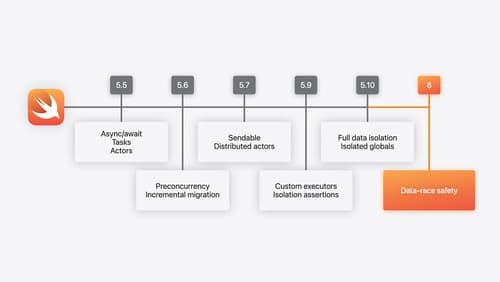DispatchSemaphore
Asked on 2025-04-12
1 search
It seems like you're interested in the topic of concurrency, specifically related to DispatchSemaphore. While the provided context does not directly mention DispatchSemaphore, it does cover various aspects of concurrency in Swift, particularly in the context of migrating to Swift 6 and using Swift's concurrency features.
Key Points on Concurrency from WWDC:
-
Swift Concurrency Model: Swift's concurrency model uses
asyncandawaitto handle asynchronous operations, allowing tasks to suspend and yield the CPU to other tasks. This is covered in the session A Swift Tour: Explore Swift’s features and design. -
Data-Race Safety: Swift 6 emphasizes data-race safety by making concurrency guarantees explicit. This includes ensuring that callbacks and delegate methods are properly isolated, often to the main actor, to prevent data races. This is discussed in the session Migrate your app to Swift 6.
-
Concurrency in Practice: The session on migrating to Swift 6 also covers practical aspects of adopting Swift's concurrency features, such as handling shared mutable state and ensuring that global variables and instances are accessed safely. This is detailed in the session Migrate your app to Swift 6.
If you have specific questions about how DispatchSemaphore might fit into Swift's concurrency model or how to migrate existing code using semaphores to Swift's new concurrency features, feel free to ask!

What’s new in Swift
Join us for an update on Swift. We’ll briefly go through a history of Swift over the past decade, and show you how the community has grown through workgroups, expanded the package ecosystem, and increased platform support. We’ll introduce you to a new language mode that achieves data-race safety by default, and a language subset that lets you run Swift on highly constrained systems. We’ll also explore some language updates including noncopyable types, typed throws, and improved C++ interoperability.

Migrate your app to Swift 6
Experience Swift 6 migration in action as we update an existing sample app. Learn how to migrate incrementally, module by module, and how the compiler helps you identify code that’s at risk of data races. Discover different techniques for ensuring clear isolation boundaries and eliminating concurrent access to shared mutable state.

Analyze heap memory
Dive into the basis for your app’s dynamic memory: the heap! Explore how to use Instruments and Xcode to measure, analyze, and fix common heap issues. We’ll also cover some techniques and best practices for diagnosing transient growth, persistent growth, and leaks in your app.
